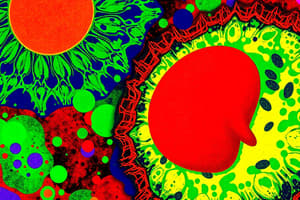Podcast
Questions and Answers
What breakthrough in cell biology occurred in the 1950s?
What breakthrough in cell biology occurred in the 1950s?
- Invention of polymerase chain reaction (PCR)
- Discovery of the structure of RNA
- Development of DNA sequencing techniques
- Ability to maintain and manipulate cells outside living organisms (correct)
What was the first continuous cell line cultured in 1951?
What was the first continuous cell line cultured in 1951?
- Jurkat cells
- HeLa cells (correct)
- MCF-7 cells
- NIH 3T3
Which technique was NOT mentioned as an advancement aiding cell biology in the 1960s?
Which technique was NOT mentioned as an advancement aiding cell biology in the 1960s?
- Discovery of green fluorescent protein
- Transfection methods
- Sterile cell culture techniques
- Western blotting (correct)
What branch of biology focuses on the study of the structure and function of cells?
What branch of biology focuses on the study of the structure and function of cells?
Who was responsible for the first culture of HeLa cells?
Who was responsible for the first culture of HeLa cells?
What significant advancement in microscopy aided cell biology research?
What significant advancement in microscopy aided cell biology research?
What was characterized alongside the growth of cell cultures in the study?
What was characterized alongside the growth of cell cultures in the study?
Which molecule discovered in jellyfish has been significant in cell biology?
Which molecule discovered in jellyfish has been significant in cell biology?
Flashcards are hidden until you start studying
Study Notes
Growth of Cell Biology
- Explosive growth in cell biology research began in the 1950s, parallel to advances in molecular biology.
- Cultivation and manipulation of cells outside living organisms became feasible.
HeLa Cells
- First continuous cell line cultured in 1951 by George Otto Gey from cervical cancer cells of Henrietta Lacks, who died the same year.
- HeLa cells represent a pivotal advancement in cell biology, akin to the role of DNA structure in molecular biology.
Advances in Cell Culture
- Significant progress in cell culture included identifying minimal media requirements for cell growth.
- Development of sterile cell culture techniques facilitated better maintenance and study of cells.
Technological Contributions
- Electron microscopy advancements enhanced the ability to visualize cellular structures.
- Later innovations included transfection methods, green fluorescent protein discovery in jellyfish, and identification of small interfering RNA (siRNA).
Continued Study of Cells
- Ongoing exploration in cytology focuses on cellular structure and function.
- Enhanced equipment such as cytology microscopes and specialized reagents has advanced cellular studies, particularly in clinical applications.
Studying That Suits You
Use AI to generate personalized quizzes and flashcards to suit your learning preferences.




